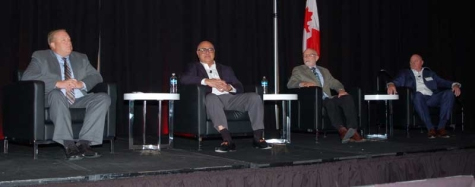A panel of representatives from a number of multi-shop collision repair operations at the MSO Symposium in Las Vegas in November discussed how disruptions in the parts supply chain are impacting their business.
All agreed the parts challenges are not limited to any particular parts segments, including new OEM, used and non-OEM.
“I think we have problems in all categories,” said Marty Evans, an MSO operator in Washington who also is COO of the Certified Collision Group banner network.
Shawn Hezar, chief client officer for Caliber Collision, agreed all the parts industry segments are facing the same challenges, in terms of labor and logistics.
“I live in Los Angeles where we can actually see the ships lined up, waiting to be docked,” he said. “And of course once they get docked, you still need trucks and people to unload them. It’s evolving, and it’s pretty painful.”
Darrell Amberson, president of operations for LaMettry’s Collision, which has 10 collision repair shops and three mechanical shops in Minnesota, concurred.
“We’re seeing it among Asian manufacturers, Europeans, domestics,” Amberson said. “It often feels like we can build three-fourths of the job or even more, but too often there’s that one critical part---even a common part, like a bumper cover---that we’re waiting months for.”
Hezar said that type of situation now means Caliber has “somewhere about $50 million to $60 million of work-in-progress…with cars sitting in parking lots, waiting to be finalized.”
Amberson, too, said his company has seen an increase of between 10% and 20% in his company’s work-in-progress compared to pre-pandemic.
“It’s a mixed blessing because in today’s world we almost have to have more work-in-progress to keep our people busy,” Amberson said. “Because there are too many jobs for which we’re waiting for insurance authorization or parts. But the downside is it creates a lot of chaos, and delays for the customer, more cycle time for the insurers.”
In some cases, other panelists acknowledged, it is impacting their customer satisfaction.
“As a general rule, yes, we are seeing CSI going down, and that’s very painful,” Evans said. “As much as we try, as much as we be proactive and communicate, you sometimes get the head nod or yes, that they understand, but the survey goes out and that conversation never took place. We’re all doing everything we can to communicate, but you’re not going to win every time.”
Hezar said Caliber was “knocking it out of the park” in terms of CSI in 2020 when work loads were down, but said 2021 “has been tough.” That in turn, he said, can have an impact on employee morale.
“Our teammates aren’t feeling as good about what is taking place either. We have to remember that,” Hezar said.
Parts supply chain challenges, the panelists said, are impacting their costs in various ways---increases they will likely need to pass on. Parts delays, for example, can lead some jobs to expand beyond a customer’s rental car allowance, a cost repairers can’t always bear in the name of customer service.
“I want to be clear: We’ve picked up a lot of rental car expenses. Our rental car expenses have gone up by millions of dollars,” Hezar said. “At some point you have to say, ‘It’s just no longer feasible. We can’t do that.’ You’re hoping the end [to the parts delays] is in sight, but based on everything we hear, these challenges are going to continue well into 2022. At some point, you have to stop.”
Are the MSOs seeing changes in parts discounts?
Amberson said he sees parts prices increasing overall but not changes in his agreements with suppliers.
That wasn’t the case among other panelists. Hezar said parts margins get squeezed when a part has to be sourced from a supplier with which his company has not had a long-time relationship.
“It’s very common that it’s not going to be the same discount. So in a lot of cases we do see it costing us more,” he said. But suppliers have also come to Caliber this year to say their costs are escalating and they “have no choice but to lower” Caliber’s discount.
“We’ve seen that from time to time,” Hezar said.
Evans joked he thinks Hezar jinxed him on the topic of changes to supplier discounts after they spoke about it the week prior to the symposium.
“I hadn’t heard a lot about it before then, but now it’s becoming more and more common,” Evans said. “Even with those you have a relationship with, we are hearing they are reducing [the] discount, which is very painful.”










John Yoswick